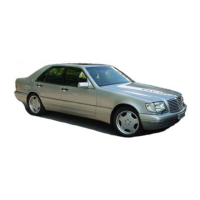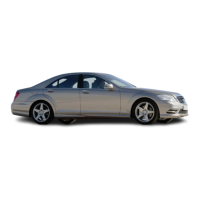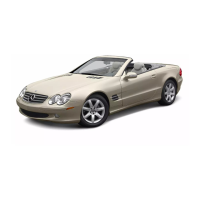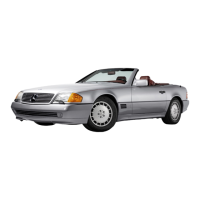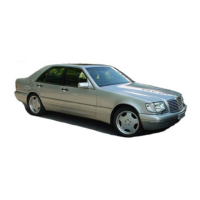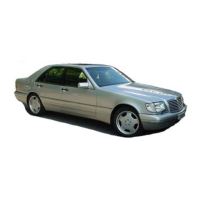
Do you have a question about the Mercedes-Benz S600 and is the answer not in the manual?
| Brand | Mercedes-Benz |
|---|---|
| Model | S600 |
| Category | Automobile |
| Language | English |
Details about warranties covering your Mercedes-Benz, including New Car, Emission, and Performance.
Guidelines for breaking in your vehicle during the initial period of ownership.
Explains symbols for high beams and other general indicator lights.
Details warning lights that should go out with the engine running, indicating potential issues.
Describes FSS and Start Lock-Out malfunction indicators in the odometer display.
Describes the Passenger Airbag automatically switched off indicator on the center console.
Steps to ensure the parking brake is engaged and how to start the engine.
Procedure for safely stopping the engine by turning the key in the steering lock.
Explains the phenomenon of aquaplaning and how to avoid it.
Details on air volume controls, adjustable air outlets, and push-buttons for center air.
Explains display symbols for modes like Auto, Economy, Defrost, and manual adjustments.
Explains the Economy mode for fuel savings, where the AC compressor does not engage.
Instructions on how to defog and defrost windows using climate control.
Details on rear climate controls: temperature selectors, air volume, outlets, and distribution slide.
Details about the master key, its remote control, and how it operates.
Information on how to obtain replacement keys for the vehicle.
Explains the functions of the remote control for locking/unlocking doors, windows, and trunk.
How to unlock the vehicle using the remote control, including selective and global modes.
Describes how to lock/unlock individual doors from inside and outside the vehicle.
Explains how to activate and deactivate the automatic central locking system.
Describes how doors automatically unlock after an accident for exit.
How to lock the trunk separately for security.
How to adjust the front seats and head restraints for optimal comfort and safety.
Describes the different parts of the multicontour backrest, including inflatable air cushions.
Explains the two heating modes and how to turn off the seat heaters manually or automatically.
How to adjust rear seat bench and individual rear seats, including backrest and seat cushion tilt.
How to activate and adjust rear head restraints using center console and door switches.
How to adjust the steering wheel's reach and height using the control switch.
Information on seat belt usage, legal requirements, and importance for safety.
Detailed instructions on how to fasten seat belts, including lap belt positioning and tightening.
Explains how the SRS and ETR activate based on impact severity and seat belt status.
Location and function of driver, front passenger, and side impact airbags.
Recommendations for properly restraining infants and children using the vehicle's seat belts.
How to operate turn signals and windshield wipers/washers.
Information on what happens if a turn signal fails.
How to use standing lamps for visibility and fog lamps for reduced visibility.
Automatic activation of low beam headlamps during driving in Canada.
How the rearview mirror's brightness adjusts automatically for night driving.
How to adjust exterior mirrors and warnings about convex passenger-side mirror.
How illuminated vanity mirrors operate for front and rear seats.
Explains operation of interior lamps, front/rear reading lamps, and courtesy lamps based on door contact.
Identifies switches for front and rear power windows, including safety switch.
How to open or close windows completely with a single press or hold.
How to disable rear window operation for child safety.
Details on selector lever positions (P, R, N, D, 4, 3, 2, 1) and program modes (S, W).
Explains accelerator positions and how to engage driving modes for optimal acceleration.
Guide on setting, adjusting, and resuming speed with the cruise control lever.
How to cancel cruise control and resume the last set speed.
Details about the parking sensors, their function, and how the system operates.
Location and function of visual and audible warning indicators for obstacles.
Explains the ABS malfunction indicator lamp and system behavior.
Safety warnings regarding ABS capabilities and driver responsibility.
Information on the BAS/ESP malfunction indicator lamp and potential system issues.
Recommendation to change engine oil for winter operation and check coolant.
Using concentrate for washer fluid in freezing temperatures.
Importance of a charged battery for starting in low temperatures.
Recommendation for M+S radial tires for winter and observing speed limits.
Steps to unlock and open the vehicle's hood.
Procedure for closing the hood safely, with warnings.
Instructions on how to check coolant level and add coolant, including safety warnings.
How to check engine oil level using the dipstick and its capacity.
Information on automatic transmission fluid level checks, noting the dipstick is omitted.
Guidelines for replacing tires, including break-in period and bolt torque.
Information on the recommended interval for rotating wheels to ensure even tire wear.
Detailed instructions on how to change a wheel, including safety precautions and blocking wheels.
Importance and procedure to adjust headlamp aim for proper visibility.
Identifies components of the headlamp assembly for bulb replacement.
Safety warnings and steps for replacing low beam (Xenon) and high beam bulbs.
Procedure to adjust headlamp vertical aim using the adjustment screw.
Safety precautions for battery handling and information on battery disposal and recycling.
Safety warnings and step-by-step instructions for jump starting a discharged battery.
Advises on using flat-bed towing, disconnecting drive shaft, and avoiding sling-type equipment.
Advice on washing the vehicle, protecting paint from external influences, and using car care products.
Steps to remove the front head restraints from the seat.
Steps to install the front head restraints into the seat.
How to remove windshield wiper blades safely.
How to install new windshield wiper blades correctly.
Specifies the location and importance of the vehicle identification number and certification tag.
Location of the engine number and other data plates for identification.
Outlines the terms of new vehicle, emission systems, performance, and California emission warranties.
Information on maximum roof and trunk load capacities.
Vehicle dimensions including length, width, height, and track.
Explains tire grades for treadwear, traction, and temperature resistance as per federal standards.


